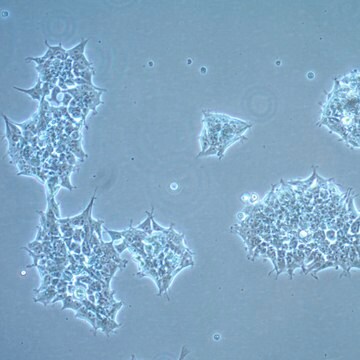293 Cell Line human
85120602, human kidney (embryonic), Epithelial
Synonym(e):
HEK-293 Cells, HEK293 Cells, Human Embryonic Kidney 293 Cells
About This Item
Empfohlene Produkte
product name
293 Cell Line human, from human kidney(embryonic), 85120602
Biologische Quelle
human kidney (embryonic)
Wachstumsmodus
Adherent
Karyotyp
2n 46, hypotriploid, modal no. 64
Morphologie
Epithelial
Produkte
Not specified
Rezeptoren
Not specified
Methode(n)
cell culture | mammalian: suitable
Versandbedingung
dry ice
Lagertemp.
−196°C
Ursprung der Zelllinie
Beschreibung der Zelllinie
Anwendung
- to study the effects of the Bt insecticidal toxins Cry1Ab and Cry1Ac alone, or with a glyphosate-based herbicide.
- for toxicological studies of ethoxylated adjuvants of glyphosate-based herbicides.
- for stable expression of either type 1 or type 2 11-βHSD (11 β-hydroxysteroid dehydrogenase) after transfection with 11-βHSD cDNA.
- as a host to transfect TLR4 cDNA (HEK-TLR4) to express TLR4 mRNA and protein and induce IL-8 (interleukin-8) promoter activity in response to NE (neutrophil elastase).
DNA-Profil
CSF1PO: 11,12
D13S317: 12,14
D16S539: 9,13
D5S818: 8,9
D7S820: 11,12
THO1: 7,9.3
TPOX: 11
vWA: 16,19
Nährmedium
Subkultur-Routine
Sonstige Hinweise
Analysenzertifikate (COA)
Suchen Sie nach Analysenzertifikate (COA), indem Sie die Lot-/Chargennummer des Produkts eingeben. Lot- und Chargennummern sind auf dem Produktetikett hinter den Wörtern ‘Lot’ oder ‘Batch’ (Lot oder Charge) zu finden.
Besitzen Sie dieses Produkt bereits?
In der Dokumentenbibliothek finden Sie die Dokumentation zu den Produkten, die Sie kürzlich erworben haben.
Artikel
Eukaryotic cell lines aid in complex post-translational modifications and folding of recombinant proteins. Find suitable recombinant protein production cell lines at sigmaaldrich.com
DNA, RNA, cDNA derived from ECACC mammalian cell lines allow screening for genes or expression patterns to identify lines most suitable for specific research.
Unser Team von Wissenschaftlern verfügt über Erfahrung in allen Forschungsbereichen einschließlich Life Science, Materialwissenschaften, chemischer Synthese, Chromatographie, Analytik und vielen mehr..
Setzen Sie sich mit dem technischen Dienst in Verbindung.








